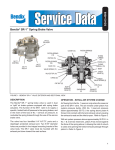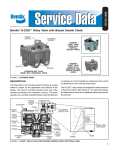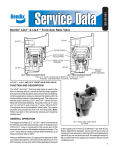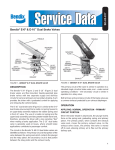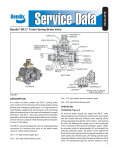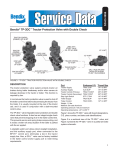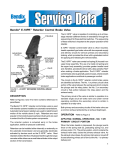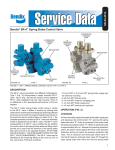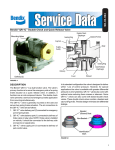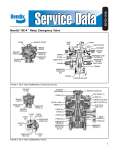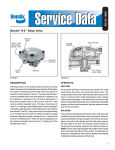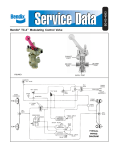Download BENDIX BW1569 User's Manual
Transcript
SD-03-1061 ® Bendix® R-8™ Relay Valve COVER ASSY. RELAY PISTON ASSY. 1/4 P.T. SERVICE 3/4 P.T. SUPPLY 1/2 P.T. DELIVERY EXHAUST COVER SCREW QUICK RELEASE DIAPHRAGM O-RING PISTON RETURN SPRING SEALING RING INLET & EXHAUST VALVE CAP NUT SEALING RING O-RING EXHAUST COVER WASHER FIGURE 1 - EXTERIOR SCREW DIAPHRAGM FIGURE 2 - SECTIONAL DESCRIPTION GENERAL OPERATION The relay valve in an air brake system functions as a relay station to speed up the application and release of the brakes. The valve is normally mounted in the proximity to the chamber it serves. The valve operates as a remote controlled brake valve that delivers or releases air to the chambers in response to the control air delivered to it from the control point. The rapid reaction of the R-8™ valve to changes in control pressures is in part due to the relatively small volume of air required between the valve cover and the relay piston. The area of the relay piston and the presence of the quick release, anti-compound feature also contribute greatly to the fast application and release of the emergency and parking brakes. The R-8™ relay valve is designed for either frame or reservoir mounting. Remote mounted valves generally have one or two 3/4" supply ports. The reservoir mounted configuration has an additional 3/4" port through the body mounting flange. Three delivery ports with various size pipe threads are provided for piping versatility. A single 1/4" service port is located in the cover which can be rotated to 90° increments. The R-8™ valve incorporates a unique, quick release and anti-compounding feature located above the service port in the cover. With the anti-compounding feature not in use, an exhaust cover is installed. When the anti-compounding feature is used, removal of the exhaust cover exposes a 1/8" pipe thread balance port. All ports on the valve are identified. APPLYING Air pressure entering the service port moves the flexible diaphragm, closing off the exhaust passage of the quick release. Air also flows around the edge of the diaphragm and into the cavity between the cover and the top of the relay piston. Air pressure acting on the surface of the piston forces it down. The exhaust valve seat moves down with the piston and seats on the inner or exhaust portion of the inlet and exhaust valve, sealing off the exhaust passage. At the same time the outer or inlet port of the inlet and exhaust valve moves off its seat, permitting supply air to flow from the reservoir past the open inlet valve and out the delivery port. 1 BALANCED OPERATING AND LEAKAGE TEST The air pressure being delivered by the open inlet valve also is effective on the bottom area of the relay piston. When this delivery air pressure beneath the piston equals the service air pressure above, the piston moves up slightly and the inlet spring returns the inlet valve to its seat. The exhaust remains closed as service line pressure balances delivery pressure. 1. Check the wheels and fully charge the air system. Adjust the brakes. RELEASING When air pressure is exhausted from the service port, the diaphragm in the quick release moves, blocking the service inlet and opening the exhaust of the quick release allowing the air that was acting on the relay piston to be exhausted at the quick release. When the air above the relay piston is exhausted, the air beneath the piston will lift the piston and the exhaust seat moves off the exhaust valve exposing the exhaust passage to atmosphere. With the exhaust passage open, the air pressure in the emergency or park actuators exhausts out the exhaust port to atmosphere. ANTI-COMPOUNDING (SIMULTANEOUS SERVICE AND PARK APPLICATION) In those applications where the R-8™ relay valve is used to control spring brake chambers, the anti-compound feature may be utilized. With the anti-compound feature of the R-8™ valve connected, a service application made while the vehicle is parked is countered by a release of the parking brakes. To utilize this feature, the exhaust cover of the quick release portion of the R-8™ valve is removed and a line is installed which is connected to the delivery of the service brake valve or relay valve. With no air pressure at the service port of the R-8™ valve, the parking brakes are applied. If a service brake application is made, air from the service brake valve enters the exhaust port of the quick release on the R-8™ valve and moves the diaphragm, blocking the service port. Air then proceeds into the cavity above the relay piston, forces the piston down, closing the exhaust and opening the inlet to deliver air to the spring brake cavity as described under the section of this manual entitled APPLYING. PREVENTIVE MAINTENANCE Important: Review the Bendix Warranty Policy before performing any intrusive maintenance procedures. A warranty may be voided if intrusive maintenance is performed during the warranty period. No two vehicles operate under identical conditions, as a result, maintenance intervals may vary. Experience is a valuable guide in determining the best maintenance interval for air brake system components. At a minimum, the valve should be inspected every 6 months or 1500 operating hours, whichever comes first, for proper operation. Should the valve not meet the elements of the operational tests noted in this document, further investigation and service of the valve may be required. 2 2. Apply and release the parking brakes several times and check for prompt response of the brakes at all appropriate wheels. 3. With the park control valve in the brakes “applied position”, coat the exhaust port with a soap solution to check for inlet valve and o-ring leakage; a 1" bubble in 5 seconds is permissible. 4. Place the park control valve in the “brakes released” position and again check at the exhaust port for leakage of the exhaust valve; a 1" bubble in 3 seconds is permissible. Apply soap solution around the valve where the cover joins the body to check for seal ring leakage; no leakage permitted. 5. With the park control still in the brakes released position, apply soap solution to the quick release exhaust port to check the diaphragm exhaust seat; a 1" bubble in 3 seconds is permitted. (NOTE: If the anti-compound feature is in use, the line attached to the R-8™ valve quick release exhaust must be disconnected to perform this test.) If the valve does not function as described above, or if leakage is excessive, it is recommended that the valve be replaced with a new or remanufactured unit, or repaired with genuine Bendix parts available at Bendix outlets. REMOVING 1. Block or hold the vehicle by means other than the brakes. 2. Drain all air brake system reservoirs. 3. Identify, mark, and disconnect all air lines from the R-8™ relay valve. 4. Remove the R-8™ valve from its mount on the vehicle. (NOTE: The inlet and exhaust valve assembly, (generally referred to as the insert) can be easily removed and replaced. Remove the exhaust cover cap screws and cover. Normally the insert can be removed without disturbing the valve mounting or connecting lines. CAUTION: DRAIN ALL RESERVOIRS BEFORE ATTEMPTING TO REMOVE THE INSERT. DISASSEMBLY 1. Prior to disassembly of the R-8 ™ valve, mark the relationship of the cover and body to facilitate assembly. 2. Remove the four 5/16" hex head cap screws and lockwashers that secure the cover to the body and separate the valve halves: remove the piston spring. (NOTE: The standard R-8™ valve does not employ a piston return spring. However, it is optionally used in some values.) 3. Remove the sealing ring from the groove in the body. 4. Remove the relay piston and o-ring from the cover. 5. Remove the service port cap nut from the cover and remove the cap nut o-ring from the cap nut. 6. Remove the quick release diaphragm from the service port. 7. If the exhaust port of the quick release is protected with a cover, remove the cover by removal of the #10-24 phillips screw. 8. Remove the #10-24 phillips screw that secure the exhaust diaphragm and washer to the exhaust cover. 9. Remove the four #10-24 phillips head screws that secure the exhaust cover to the body. 10. Remove the inlet/exhaust valve insert from the body. (NOTE: If a new inlet/exhaust value insert is to be installed, omit step 11.) 11. Disassemble the insert by removing the retaining ring and separating; the special washer, o-ring retainer and o-rings, the valve spring, valve retainer and the inlet and exhaust valve. CLEANING AND INSPECTION 1. Wash all metal parts in mineral spirits and dry them thoroughly. (NOTE: When rebuilding the R-8™ valve, all springs and all rubber parts should be replaced.) 2. Inspect all metal parts for deterioration and wear, as evidenced by scratches, scoring and corrosion. 3. Inspect the exhaust valve seat on the relay piston for nicks and scratches which could cause excessive leakage. 4. Inspect the inlet valve seat in the body for scratches and nicks, which could cause excessive leakage. (NOTE: All torques specified in this manual are assembly torques and can be expected to fall off, after assembly. Do not retorque after initial assembly torques fall. To convert inch pounds of torque to foot pounds of torque, divide inch pounds by 12. Inch Pounds 12 =Foot Pounds To convert foot pounds of torque to inch pounds of torque multiply foot pounds by 12. Foot pounds x 12 = Inch pounds For assembly, hand wrenches are recommended. 1. Install the o-ring on the service port cap nut. 2. Place the quick release diaphragm in the R-8™ valve cover: be certain it is positioned down between the guide ribs in the cover. Install the service port cap nut. Torque to approximately 150 inch pounds. 3. If the quick release exhaust port was protected with an exhaust cover, install the cover using one of the #10-24 phillips head screws. Torque to approx. 15-25 inch pounds. 4. Install o-ring on the relay piston and install the piston in the cover. (NOTE: If a new inlet/exhaust valve insert is used, omit steps 5-8.) 5. Place the inlet/exhaust valve, rubber side down, on a clean flat surface. Install the valve retainer then the spring on the inlet exhaust valve. 6. Install the two o-rings in their appropriate grooves in the o-ring retainer and place the special washer over the o-rings. 7. While holding the o-ring retainer and special washer together, install them over the inlet and exhaust valve, making sure the inlet valve spring is bearing on the o-ring retainer 5. Inspect the exhaust seat of the quick release diaphragm in the R-8™ valve cover and make sure all internal air passages in this area are open and clean and free of nicks and scratches. 8. Install the retainer ring in the groove around the inlet and exhaust valve while holding the assembly compressed. 6. Replace all parts not considered serviceable during these inspections and all springs and rubber parts. Use only genuine Bendix replacement parts which are available from Bendix outlets. 10. Place the exhaust cover on the body and secure it using the four #10-24 phillips head screws. Torque the screws to 20-30 inch pounds. ASSEMBLY Prior to reassembling the R-8™ relay valve, lubricate all o-rings, o-ring grooves, piston bores and metal to metal moving surfaces with Dow Corning Silicone 55-M Pneumatic Grease (Bendix pc. 291126). 9. Install the inlet/exhaust valve insert in the body bore. 11. Place the exhaust diaphragm on the exhaust cover and secure it using the diaphragm washer and the remaining #10-24 phillips head screw. Torque the screw to approximately 5-10 inch pounds. 12. Prior to assembling the cover to the body note the mark made during disassembly to obtain the proper cover body relationship. 3 13. Place the piston return spring (if so equipped) on the piston within the cover. 14. Install the seal ring in the groove of the R-8™ valve body and join the two valve halves together. 15. Secure the body to the cover using the four 5/16-18 hex head cap screws. Torque to approximately 80-120 inch pounds. INSTALLING Prior to installing the R-8™ valve on the vehicle, all connecting air lines should be inspected for kinks, cuts, chafing and deterioration. Repair or replace as necessary. 1. Mount the R-8™ relay valve securely. 2. Connect all air lines to the proper ports, using the identification markings of the lines made before valve was removed. 3. Test all reconnected air line fittings for leakage. 4. Test valve as outlined in “operating and leakage tests” section. WARNING! PLEASE READ AND FOLLOW THESE INSTRUCTIONS TO AVOID PERSONAL INJURY OR DEATH: When working on or around a vehicle, the following general precautions should be observed at all times. 1. Park the vehicle on a level surface, apply the parking brakes, and always block the wheels. Always wear safety glasses. 2. Stop the engine and remove ignition key when working under or around the vehicle. When working in the engine compartment, the engine should be shut off and the ignition key should be removed. Where circumstances require that the engine be in operation, EXTREME CAUTION should be used to prevent personal injury resulting from contact with moving, rotating, leaking, heated or electrically charged components. 4 3. Do not attempt to install, remove, disassemble or assemble a component until you have read and thoroughly understand the recommended procedures. Use only the proper tools and observe all precautions pertaining to use of those tools. 4. If the work is being performed on the vehicle’s air brake system, or any auxiliary pressurized air systems, make certain to drain the air pressure from all reservoirs before beginning ANY work on the vehicle. If the vehicle is equipped with an AD-IS™ air dryer system or a dryer reservoir module, be sure to drain the purge reservoir. 5. Following the vehicle manufacturer’s recommended procedures, deactivate the electrical system in a manner that safely removes all electrical power from the vehicle. 6. Never exceed manufacturer’s recommended pressures. 7. Never connect or disconnect a hose or line containing pressure; it may whip. Never remove a component or plug unless you are certain all system pressure has been depleted. 8. Use only genuine Bendix ® replacement parts, components and kits. Replacement hardware, tubing, hose, fittings, etc. must be of equivalent size, type and strength as original equipment and be designed specifically for such applications and systems. 9. Components with stripped threads or damaged parts should be replaced rather than repaired. Do not attempt repairs requiring machining or welding unless specifically stated and approved by the vehicle and component manufacturer. 10. Prior to returning the vehicle to service, make certain all components and systems are restored to their proper operating condition. BW1569 © 2004 Bendix Commercial Vehicle Systems LLC. All rights reserved. 3/2004 Printed in U.S.A.





